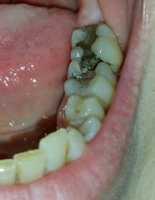
12 Feb PFAS Chemicals Found in Drinking Water Linked to Tooth Decay in Children
MedicalResearch.com Interview with:

Dr. Wiener and Christopher Waters, Research Labs Director, WVU School of Dentistry
R. Constance Wiener, DMD, PhD
Associate Professor
West Virginia University School of Dentistry
MedicalResearch.com: What is the background for this study?
Response: Perfluoroalkyl and polyfluoroalkyl substances (PFAS) are chemical groups that have had a wide variety of uses due to their ability to their ability to repel water and stains. They might be found in food packaging, water-repellant clothing and carpeting, paints, fire-fighting foam, and water, for example. Although many are no longer manufactured in the United States, PFAS persist in the environment as they do not readily break down. Adverse health effects have been speculated especially for low birthweight babies, immunological effects, certain cancers and thyroid hormone disruption.1 With these considerations, we hypothesized that there may be an association of PFAS with tooth development and subsequent dental caries (cavities).
MedicalResearch.com: What are the main findings?
Response: We used national data for the study. There were 629 children who participated in the National Health and Nutrition Examination Survey, 2013-2014 whose parents/guardians consented for PFAS laboratory studies and whose ages were three to eleven. From these available data we examined seven PFAS. One of the seven, perfluorodecanoic acid was associated with higher levels of dental caries.
MedicalResearch.com: What should readers take away from your report?
Response: All of the health effects of PFAS are unknown. Although PFAS provide stain resistance and water repellence, they have drawbacks. They can accumulate and stay in the body over time.1 PFAS are still produced in other countries and may be imported into the U.S. where consumers unwittingly are exposed through products such as leather, rubber, plastics, etc.1 The EPA recommends funding for the impact of PFAS on agriculture and the development of groundwater cleanup.1
MedicalResearch.com: What recommendations do you have for future research as a result of this work?
Response: The Environmental Protection Agency (EPA) has actions to address PFAS. Several cities (such as Exeter, NH; Horsham, PA; Colorado Springs, CO, Fayetteville, NC; and, Leavenworth, KS) have been more widely impacted than others and the EPA has met with stakeholders to coordinate efforts to face the issue.2 As there are other health issues also involved, continuing monitoring is important. With each birth cohort of children there should be fewer exposures to PFAS. This needs to be surveilled now and in the future.
MedicalResearch.com: Is there anything else you would like to add? Any disclosures?
Response: Research reported in this publication was supported by the National Institute of General Medical Sciences of the National Institutes of Health under Award Number 5U54GM104942-04. The content is solely the responsibility of the authors and does not necessarily represent the official views of the National Institutes of Health.
- PFOA, PFOS and Other PFASs. Basic Information on PFAS. United States Environmental Protection Agency. 2018. https://www.epa.gov/pfas/basic-information-pfas
- PFAS Community Engagement. United States Environmental Protection Agency. 2019. https://www.epa.gov/pfas/pfas-community-engagement
Citation:
Title: Perfluoroalkyls/polyfluoroalkyl substances and dental caries experience in children, ages 3-11 years, National Health and Nutrition Examination Survey, 2013-2014
DOI: 10.1111/jphd.12329
CONTACT: Sunshine Wiles
WVU School of Dentistry
304-293-6133; [email protected]
[subscribe]
Last Modified : [last-modified]
The information on MedicalResearch.com is provided for educational purposes only, and is in no way intended to diagnose, cure, or treat any medical or other condition. Always seek the advice of your physician or other qualified health and ask your doctor any questions you may have regarding a medical condition. In addition to all other limitations and disclaimers in this agreement, service provider and its third party providers disclaim any liability or loss in connection with the content provided on this website.
Last Updated on February 12, 2020 by Marie Benz MD FAAD
